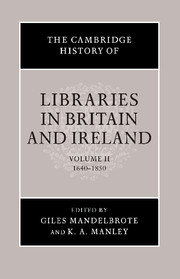Book contents
- Frontmatter
- 1 Introduction: the changing world of libraries – from cloister to hearth
- PART ONE THE EXPANSION OF BOOK COLLECTIONS 1640–1750
- PART TWO LIBRARY DEVELOPMENT AT A LOCAL LEVEL
- PART THREE PROVINCIAL AND METROPOLITAN LIBRARIES 1750–1850
- 18 Libraries in context: social, cultural and intellectual background
- 19 The book trade and libraries
- 20 Ecclesiastical libraries
- 21 Libraries in the parish
- 22 Books and universities
- 23 Libraries and literacy in popular education
- 24 Scientific and medical libraries: the rise of the institution
- 25 The first century of the British Museum library
- 26 The impact of the British Museum library
- 27 Private libraries in the age of bibliomania
- 28 Library architecture and interiors
- 29 Library management in the pre-professional age
- 30 Libraries for an imperial power
- 31 Engines of literature: libraries in an era of expansion and transition
- Select bibliography
- Index
- References
26 - The impact of the British Museum library
from PART THREE - PROVINCIAL AND METROPOLITAN LIBRARIES 1750–1850
Published online by Cambridge University Press: 28 March 2008
- Frontmatter
- 1 Introduction: the changing world of libraries – from cloister to hearth
- PART ONE THE EXPANSION OF BOOK COLLECTIONS 1640–1750
- PART TWO LIBRARY DEVELOPMENT AT A LOCAL LEVEL
- PART THREE PROVINCIAL AND METROPOLITAN LIBRARIES 1750–1850
- 18 Libraries in context: social, cultural and intellectual background
- 19 The book trade and libraries
- 20 Ecclesiastical libraries
- 21 Libraries in the parish
- 22 Books and universities
- 23 Libraries and literacy in popular education
- 24 Scientific and medical libraries: the rise of the institution
- 25 The first century of the British Museum library
- 26 The impact of the British Museum library
- 27 Private libraries in the age of bibliomania
- 28 Library architecture and interiors
- 29 Library management in the pre-professional age
- 30 Libraries for an imperial power
- 31 Engines of literature: libraries in an era of expansion and transition
- Select bibliography
- Index
- References
Summary
1753–1800
It may be a measure of the relative importance of the British Museum that histories of London in the Hanoverian period make little mention of it, and none at all of its library. It is absent from M. Dorothy George’s London life in the eighteenth century. George Rudé mentions Montagu House – ‘merged with the British Museum in 1755’ – among aristocratic houses, and Hans Sloane, whose collection of antiquities ‘became the nucleus of that in the British Museum’. Francis Sheppard has three brief passing references to the museum, two among plans for the development of London’s infrastructure and one among the expansion of cultural institutions. Paul Langford’s main concern is the neglect of the museum by George III in favour of the Royal Academy. And Peter Ackroyd’s London: the biography refers only to the ‘building stone’. Works devoted to library history are not particularly forthcoming either. Paul Kaufman’s Libraries and their users, albeit focused mainly on provincial libraries, contains not even a passing mention of the British Museum library. And P. R. Harris’s magisterial History of the British Museum library devotes only some twenty-six pages (of a text of 686) to the period 1753 to 1798.
This neglect is due to a certain extent to the infrastructure of London in the mid-eighteenth century. Great Russell Street ‘marked for all practical purposes the northern boundary of urban Bloomsbury’. Montagu House, the first of many buildings to house the museum and library, was ‘outside’ (as it were), one of a number of stately, if not princely, houses (John Evelyn called the original ‘Mr Montagues new Palace neere Bloomesbery’), which ‘some, like the aristocracy, sought [for] occasional or prolonged escape … to the neighbouring countryside’, as did an increasing number of Londoners seeking to avoid the unwholesome and unhealthy urban environment.
- Type
- Chapter
- Information
- The Cambridge History of Libraries in Britain and Ireland , pp. 422 - 437Publisher: Cambridge University PressPrint publication year: 2006



